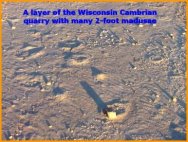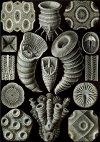Phylum Cnidaria
Phylum CnidariaKingdom Animalia (or Metazoa) |
Also see: | |||||||||||
 Phylum
Cnidaria comprises incredibly diverse creatures, including colonial
siphonophores, massive medusae jellyfish, box jelly fish, corals.
Cnidarian kinship through a common ancestor is based on the common
characteristic of stinging cells called nematocysts that they all
possess. In fact, the name Cnidaria (silent C) comes from the Greek
word "cnidos" that means stinging nettle. Phylum
Cnidaria comprises incredibly diverse creatures, including colonial
siphonophores, massive medusae jellyfish, box jelly fish, corals.
Cnidarian kinship through a common ancestor is based on the common
characteristic of stinging cells called nematocysts that they all
possess. In fact, the name Cnidaria (silent C) comes from the Greek
word "cnidos" that means stinging nettle. The
Cnidarian fossil record reaches back further than any other animals
to the Vendian. Those Cnidarians lacking mineralized skeletons
are, of course, exceedingly rare, while cnidarians that possessed
hard skeletons, in particular the corals, have left a prodigious
fossil record. Coral fossils are sparse in the Cambrian Period,
since a major radiation did not occur until the Lower Scyphozoans are extremely rare as fossils, being comprised of soft bodies that can only be preserved under extremely rare conditions. A few possible but poorly known scyphozoans have been described from the Vendian (Late Precambrian), but ichnofossils are known as far back as the Middle Cambrian.
|
||||||||||||
Fossil
Museum Navigation:
Home Geological Time Paleobiology Geological History Tree of Life Fossil Sites Fossils Evolution Fossil Record Museum Fossils |


